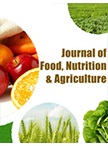Evaluation of yellow maize inbred lines for maturity and grain yield related traits using line×tester analysis
DOI:
https://doi.org/10.21839/jfna.2018.v1i1.205Keywords:
General combining ability, Heterosis, Maize, Specific combining ability, Tester analysisAbstract
Thirty yellow maize inbred lines were selected from different source populations and planted in isolation with common male testers (YD-2 and YD-4) in 1:4:1 ratio at Cereal Crop Research Institute (CCRI) Pirsabak, Nowshera during spring-2014 (season–I). On the bases of best seed setting and other important traits, eighteen test-crosses were selected using line × tester approach. The developed 18 test-crosses, nine parental lines and two testers along with two check cultivars (Sarhad Yellow and CS2Y10) were grown in summer season-2014 (July – November) using two replications.Data were collected on various maturities and yield related traits via; days to pollen shedding, silking, ear height, plant height, 100-kernel weight, kernel row ear-1 and grain yield. Significant differences were observed among test-crosses for yield related traits mainly 100-kernel weight and grain yield. L-9 using YD-4 as a tester revealed minimum days to pollen shedding (50.5 days) and days to silking (52.5 days). L-3 using YD-2 as a tester recorded maximum plant height while, L-9 using YD-4 as a tester obtained maximum ear height and length. L-9 using YD-4 as a tester revealed high 100-kernel weight, grain yield and high GCA effect, while L-8 using YD-4 as a tester recorded high SCA effect for 100-kernel weight. L-9 exhibited high GCA effect for grain yield while, high SCA effect was obtained for L-2 using tester (YD-2). L-9 using tester YD-4 revealed maximum mid-parent and best-parent heterosis for ear length and grain yield. For maximum traits, L-9 was the best combiner followed by L-3 and L-6 using the same tester (YD-4) under conducted study.
Downloads
References
Desai, S.A., and Singh, R. (2001). Combining ability studies for some morphophysiological and biochemical traits related to drought tolerance in maize (Zea mays L.)". The Indian Journal of Genetics and Plant Breeding, 61, 34-36.
Dickert, T., and Tracy, W. (2002). Heterosis for flowering time and agronomic traits among early open-pollinated sweet corn cultivars. Journal of the American Society for Horticultural Science, 127, 793-797.
Gorgulho, E.P., and Filho, J.B.D.M. (2001). Evaluation of maize varieties in the partial diallel mating scheme. Bragantia, 60, 1-8.
Gupta, S., and Nagda, A. (2000). Analysis of variety diallel cross for yield and its components in winter maize (Zea mays L.). Indian Journal of Genetics and Plant Breeding, 60, 301-303.
Hahn, S., Isoba, J.C., and Ikotun, T. (1989). Resistance breeding in root and tuber crops at the International Institute of Tropical Agriculture (IITA), Ibadan, Nigeria. Crop Protection, 8, 147-168.
Kempthorne, O., (1957). An introduction to genetic statistics." John Wiley And Sons, Inc.; New York.
Khan, K., Iqbal, M., Shah, Z., Ahmad, B., Azim, A., and Sher, H. (2003). Grain and stover yield of corn with varying times of plant density reduction. Pakistan Journal of Biological Sciences, 6, 1641-1643.
Kiani, G., Nematzadeh, G.A., Kazemitabar, S.K., and Alishah, O. (2007). Combining ability in cotton cultivars for agronomic traits. International Journal of Agriculture and Biology, 9(3), 521-522.
Konak, C., Ayd?n, Ü., Basal, H., and Serter, E. (2015). Combining ability and heterotic effects in some characteristics of second crop maize. Turkish Journal of Field Crops, 6, 64-70.
Krivanek, A.F., De Groote, H., Gunaratna, N.S., Diallo, A.O., and Friesen, D. (2007). Breeding and disseminating quality protein maize (QPM) for Africa. African Journal of Biotechnology, 6(4), 312-324.
Lee, M., (1998). Genome projects and gene pools: New germplasm for plant breeding?. Proceedings of the National Academy of Sciences, 95, 2001-2004.
Lippman, Z.B., and D. Zamir. (2007). Heterosis: Revisiting the magic. Trends in Genetics, 23, 60-66.
Mendoza, M., Oyervides, A., and López, A. (2000). New maize cultivars with agronomic potential for the humid-tropics. Mesoamerican Agronomy 11, 83-88.
Menkir, A., and Ingelbrecht, I. (2007). Testcross performance and diversity analysis of white maize lines derived from backcrosses containing exotic germplasm. Euphytica 155, 417-428.
Misevic, D., (1989). Heterotic patterns among us corn belt, yugoslavian, and exotic maize populations.Maydica (Italy).
Morris, M.L., Risopoulos, J., and Beck, D. (1999). Genetic change in farmer-recycled maize seed. A review of the evidence. CIMMYT Economics Working Paper, CIMMYT. Series: Mexico.
Morrison, F. (1936). Feeds and feeding, 20th Eds. Morrison Publishing Co. USA
Paterniani, M.E.A.G.Z., Sawazaki, E., Dudienas, C., Duarte, A.P., Gallo, P.B. (2000). Diallel crosses among maize lines with emphasis on resistance to foliar diseases. Genetics and Molecular Biology, 23, 381-385.
Rahman, H., Arifuddin, Shah, Z., Shah, S.M.A., Iqbal, M., and Khalil, I.H. 2012. Evaluation of maize s2 lines in test cross combinations II: Yield and yield components. Pakistan Journal of Botany, 44, 187-192.
de la Rosa, A., de León, H., Martínez, G. , and Rincón, F. (2000). Heterosis, combining ability and genetic diversity in commercial hybrids of maize (Zea mays L.). Agronomia Mesoamericana, 11, 113-122.
Saleh, G.B., Abdullah, D., and Anuar, A.R. (2002). Performance, heterosis and heritability in selected tropical maize single, double and three-way cross hybrids. The Journal of Agricultural Science, 138, 21-28.
Sing, R., and Chaudhary, B.. (1979). Line×tester analysis. I: Biometrical methods in quantitative genetics. New Delhi: Kalyani publishers, India.
Vasal, S., Srinivasan, G., Han, G.C., and Gonzalez, C.F. (1992). Heterotic patterns of eighty-eight white subtropical cimmyt maize lines. Maydica, 37 : 319-327.






 .
.